Did you know that red cabbage is more than just a vibrant addition to your plate? This humble vegetable packs a powerful punch when it comes to health benefits. From supporting heart health to fighting inflammation and even containing anti-cancer compounds, red cabbage is a nutritional powerhouse that you shouldn’t overlook. Plus, it’s incredibly versatile and can be easily incorporated into a variety of delicious recipes.
Key Takeaways:
- Red cabbage is rich in antioxidants, which help protect your body from oxidative damage.
- Incorporating red cabbage into your diet may support heart health and reduce the risk of cardiovascular disease.
- The compounds found in red cabbage have anti-inflammatory properties and may help fight against cancer.
- Red cabbage is also beneficial for gut health due to its fiber content and can promote the production of beneficial short-chain fatty acids in the gut.
- With its vibrant color and versatile nature, red cabbage can be used in a variety of delicious recipes to enhance your overall health and well-being.
What is Red Cabbage?
Red cabbage is a type of cabbage that belongs to the brassica group of vegetables, along with other nutritious options like brussels sprouts and kale. It offers a unique combination of taste, texture, and versatility that makes it a popular choice in various culinary dishes.
When consumed raw, red cabbage has a distinct peppery taste and a satisfying crunch. However, when cooked, it becomes sweeter and develops a softer texture. This versatility allows red cabbage to be used in a wide range of recipes, from fresh salads to hearty soups and stir-fries.
The harvest of red cabbage involves picking the whole plant and removing the outer leaves, ultimately leaving just the cabbage head. This ensures that only the most flavorful and tender parts are included in cooking and preparation. Furthermore, this process helps to optimize the quality and taste of the final dish.
Red cabbage is a vibrant and nutritious vegetable that provides both visual appeal and a delightful flavor profile to any meal.
Red cabbage is typically in season from September to December in the UK, meaning it is readily available during the autumn and winter months. This seasonality adds to its allure, encouraging individuals to incorporate this nutritious vegetable into their seasonal recipes.
Red Cabbage Harvest and Leaves
During the harvest of red cabbage, the outer leaves are discarded, as they may be tough and less desirable for consumption. This process ensures that only the most tender and flavorful leaves are used in culinary preparations.
The leaves of red cabbage play a crucial role in protecting the tender cabbage head as it grows. They shield the head from the elements and provide essential nutrients to support its growth and development. While not typically consumed directly, these leaves make a valuable contribution to the overall vitality and quality of the cabbage.
The Nutritional Value of Red Cabbage
To better understand the nutritional benefits of red cabbage, let’s explore its essential nutrients:
| Nutrient | Amount per 100g |
|---|---|
| Calories | 31 kcal |
| Protein | 1.4g |
| Fat | 0.2g |
| Carbohydrates | 6.9g |
| Fiber | 2.1g |
| Vitamin C | 36.6mg |
| Potassium | 243mg |
Red cabbage is low in calories and fat, making it a nutritious addition to a balanced diet. It is also a good source of dietary fiber, which aids digestion and promotes a healthy gut. Furthermore, red cabbage is rich in vitamin C, which supports immune function and contributes to the body’s production of collagen.
Additionally, red cabbage provides potassium, an essential mineral that helps regulate blood pressure and maintain proper muscle function. These nutritional qualities make red cabbage an excellent choice for enhancing your overall well-being.
Red Cabbage Health Benefits
Incorporating red cabbage into your diet can offer a multitude of health benefits. This vibrant vegetable is packed with antioxidants, including anthocyanins, which give it its beautiful purple color. These antioxidants play a crucial role in combating oxidative damage within the body, helping to maintain overall health and well-being.
One of the key advantages of red cabbage is its potential positive impact on heart health. The antioxidants found in red cabbage have been associated with reducing the risk of cardiovascular disease, promoting a healthier heart. By including red cabbage in your meals, you are taking a proactive step towards supporting your heart’s vitality and longevity.
Furthermore, red cabbage contains compounds that possess anti-inflammatory properties. Inflammation is a natural response to injury or infection, but chronic inflammation can contribute to the development of various diseases. The anti-inflammatory properties found in red cabbage may help to alleviate inflammation in the body and reduce the risk of chronic conditions.
Red cabbage is also rich in anti-cancer compounds, making it a valuable addition to a cancer-preventive diet. The presence of specific compounds within red cabbage has been linked to the inhibition of cancer cell growth, particularly in colorectal cancer. Regular consumption of red cabbage may therefore play a role in reducing the risk of this common form of cancer.
In addition to its antioxidant and anti-cancer properties, red cabbage is an excellent source of fiber. Fiber is essential for maintaining a healthy digestive system and promoting gut health. When consumed, red cabbage’s fiber content encourages the production of beneficial short-chain fatty acids in the gut, contributing to overall gut well-being.
To summarize, the health benefits of red cabbage include:
- Protection against oxidative damage with its antioxidant content
- Potential improvement in heart health
- Reduction of inflammation within the body
- Possible anti-cancer effects, particularly against colorectal cancer
- Promotion of gut health through its fiber content and support for beneficial short-chain fatty acid production
By incorporating red cabbage into your meals, you can enjoy these health benefits while savoring its vibrant flavor and versatility.
Nutritional Profile of Red Cabbage
When it comes to nutrition, red cabbage packs a powerful punch. Let’s take a closer look at the essential nutrients it provides:
| Nutrient | Amount per 80g Portion |
|---|---|
| Calories | 12kcal/49KJ |
| Protein | 0.6g |
| Fat | 0.2g |
| Carbohydrates | 1.8g |
| Fiber | 1.8g |
| Potassium | — |
| Folate | — |
| Vitamin C | — |
Just an 80g portion of red cabbage counts as one of your five-a-day, making it a great way to boost your vegetable intake.
Red cabbage’s low calorie and fat content make it an excellent choice for those watching their weight. It also provides a good amount of fiber, which aids in digestion and helps keep you feeling full and satisfied.
While the precise levels of potassium, folate, and vitamin C in red cabbage may vary, they all contribute to the overall nutritional value of this colorful vegetable. Potassium is important for maintaining healthy blood pressure levels, while folate plays a crucial role in cell growth and development. Vitamin C is a potent antioxidant that supports immune function and collagen formation.
Include red cabbage in your diet and enjoy its nutritional benefits along with its vibrant flavor and versatility.
Top 5 Health Benefits of Red Cabbage
Red cabbage offers a multitude of health benefits that make it a valuable addition to your diet. From its richness in protective antioxidants to its contribution to heart health and anti-cancer properties, here are the top five health benefits of red cabbage:
-
Protective Antioxidants
The vibrant purple hue of red cabbage is due to its high content of antioxidants, including anthocyanins. These antioxidants help combat oxidative damage in the body, protecting cells from harmful free radicals [1].
-
Heart Health
Research suggests that regular consumption of red cabbage may support heart health by reducing the risk of cardiovascular disease. The antioxidants and phytochemicals found in red cabbage contribute to its cardio-protective properties [2].
-
Inflammation
Red cabbage contains compounds that possess anti-inflammatory properties, which can help alleviate inflammation in the body. By reducing inflammation, red cabbage may contribute to overall well-being and reduced risk of chronic diseases [3].
-
Anti-Cancer Compounds
Studies have shown that red cabbage contains compounds that have potential anti-cancer properties. These compounds, such as indole-3-carbinol and sulforaphane, may help inhibit the growth of cancer cells, particularly in colorectal cancer [4].
-
Gut Health
The fiber content in red cabbage promotes gut health by supporting regular bowel movements and providing food for beneficial gut bacteria. This helps maintain a healthy digestive system and encourages the production of short-chain fatty acids [5].
With its numerous health benefits, red cabbage is a powerful vegetable that can enhance your well-being. Consider incorporating it into your meals to reap the advantages it offers.
| Benefit | Explanation |
|---|---|
| Protective Antioxidants | Red cabbage is rich in antioxidants, including anthocyanins, which fight oxidative damage in the body [1]. |
| Heart Health | Regular consumption of red cabbage may reduce the risk of cardiovascular disease, thanks to its cardio-protective properties [2]. |
| Inflammation | Compounds found in red cabbage have anti-inflammatory properties, beneficial for overall health [3]. |
| Anti-Cancer Compounds | Red cabbage contains compounds that can inhibit the growth of cancer cells, especially in colorectal cancer [4]. |
| Gut Health | The fiber in red cabbage supports gut health by promoting regular bowel movements and nourishing beneficial gut bacteria [5]. |
Red Cabbage Safety and Considerations
While red cabbage is generally safe for most people, it is important to be aware of certain considerations.
- Allergies: Some individuals may be allergic to cabbage or experience cross-reactivity with other plants. If you have a known allergy to cabbage or any related vegetables, it is advisable to avoid red cabbage.
- Thyroid Issues: People with thyroid issues, such as hypothyroidism or hyperthyroidism, may need to limit their intake of brassica vegetables, including red cabbage. These vegetables contain goitrogens, which can interfere with iodine absorption and thyroid function. Consult with your healthcare provider for personalized advice.
- High-Fiber Foods: Red cabbage is a high-fiber food, which can be beneficial for digestion and overall health. However, some individuals may experience bloating and gas when consuming large quantities of fiber. If you have a sensitive digestive system, it is advisable to start with smaller portions and gradually increase your intake of red cabbage.
- Blood-Thinning Medication: If you are taking blood-thinning medication, such as warfarin, it is important to be mindful of your vitamin K intake. Red cabbage is a good source of vitamin K, which plays a role in blood clotting. Consult with your healthcare provider to determine if you need to monitor or adjust your vitamin K intake while on blood-thinning medication.
Nutritional Comparison of Red Cabbage and Green Cabbage
| Nutrient | Red Cabbage (per 100g) | Green Cabbage (per 100g) |
|---|---|---|
| Calories | 31 | 25 |
| Protein | 1.4g | 1.3g |
| Fat | 0.2g | 0.2g |
| Carbohydrates | 7.4g | 5.8g |
| Fiber | 2.1g | 2.2g |
| Vitamin C | 57% of Daily Value | 61% of Daily Value |
| Vitamin K | 88% of Daily Value | 72% of Daily Value |
| Potassium | 8% of Daily Value | 6% of Daily Value |
Note: The nutritional values may vary depending on the specific variety and preparation method of the cabbage.
Including Red Cabbage in Your Diet
Red cabbage is a versatile vegetable that can be enjoyed in a variety of ways. Whether you prefer traditional recipes or want to get creative, there are numerous ways to incorporate red cabbage into your diet. Here are some ideas:
Traditional braised red cabbage recipes often combine it with ingredients like apples, sugar, cider, port, or wine to balance its peppery flavors. Adding whole fruits like apples naturally sweetens the dish and creates a delightful blend of tastes.
You can also use red cabbage to create refreshing slaw, flavorful salads, or hearty soups. Its crunchy texture and vibrant color add a unique twist to these dishes.
For a delicious side dish, consider roasting or steaming red cabbage. Roasting brings out its natural sweetness, while steaming preserves its crispiness. Either way, it makes a delightful addition to any meal.
If you love stir-fries or wraps, don’t hesitate to add red cabbage to your recipes. Its robust flavor and firm texture complement the other ingredients and add a satisfying crunch.
Now that you know the versatility of red cabbage, it’s time to explore some mouthwatering recipes. Here’s a small collection to inspire you:
Red Cabbage Recipes:
- Braised Red Cabbage with Apples and Wine
- Red Cabbage Slaw with Honey Mustard Dressing
- Roasted Red Cabbage Wedges with Balsamic Glaze
- Asian-inspired Red Cabbage Stir-Fry with Sesame
- Red Cabbage and Beetroot Salad with Citrus Dressing
Feel free to experiment with these recipes and customize them to your taste. Don’t be afraid to add your favorite spices and seasonings to make each dish uniquely yours.
| Recipe | Description |
|---|---|
| Braised Red Cabbage with Apples and Wine | In this classic recipe, red cabbage is cooked with apples, sugar, cider, port, or wine to create a sweet and savory side dish. |
| Red Cabbage Slaw with Honey Mustard Dressing | This refreshing slaw combines shredded red cabbage with a tangy honey mustard dressing for a satisfying crunch. |
| Roasted Red Cabbage Wedges with Balsamic Glaze | Roasting red cabbage wedges brings out their natural sweetness and pairs perfectly with a drizzle of balsamic glaze. |
| Asian-inspired Red Cabbage Stir-Fry with Sesame | Add a touch of Asian flavors to your meal with this stir-fry recipe that features red cabbage, sesame oil, and other delicious ingredients. |
| Red Cabbage and Beetroot Salad with Citrus Dressing | This vibrant salad combines red cabbage and beetroot with a zesty citrus dressing, creating a burst of colors and flavors. |
Nutritional Comparison: Red Cabbage vs. Green Cabbage
When it comes to nutrition, both red and green cabbage offer valuable benefits. However, red cabbage stands out with its higher levels of antioxidants, including anthocyanins. These antioxidants not only give red cabbage its vibrant color but also provide additional health benefits.
Let’s take a closer look at the nutritional profiles of both types of cabbage:
| Cabbage Type | Antioxidants | Vitamins | Minerals |
|---|---|---|---|
| Red Cabbage | High levels, including anthocyanins | Rich in vitamin C and vitamin K | Good source of minerals |
| Green Cabbage | Lower levels compared to red cabbage | Also contains vitamin C and vitamin K | Provides essential minerals |
Both red and green cabbage are excellent sources of vitamins, including vitamin C and vitamin K, which are important for overall health and well-being. They also offer a good amount of fiber, which aids in digestion and promotes satiety.
While red cabbage steals the show with its higher antioxidant content, green cabbage should not be overlooked. It still provides a range of essential vitamins and minerals that support various bodily functions.
With this information, you can choose between red and green cabbage based on your taste preferences and nutritional needs. Both types of cabbage are versatile and can be enjoyed in a variety of dishes, from salads and slaws to soups and stir-fries.
Other Health Benefits of Cabbage
Cabbage, including red cabbage, offers a range of additional health benefits that make it a valuable addition to a healthy diet. Let’s explore some of these benefits:
1. Reducing Breastfeeding Discomfort
Green cabbage is known for its ability to alleviate breastfeeding discomfort in nursing mothers. Placing chilled cabbage leaves on the breasts can help reduce inflammation and relieve pain associated with engorgement or mastitis.
2. Lowering the Risk of Diabetes
Regular consumption of cabbage, including both red and green varieties, may help lower the risk of developing type 2 diabetes. Cabbage is a low-calorie vegetable rich in fiber, which can assist in maintaining healthy blood sugar levels.
3. Supporting Brain Health
Cabbage contains certain compounds that have been linked to improvements in cognitive function and brain health. The antioxidants and phytochemicals present in cabbage may help protect against age-related cognitive decline and promote overall brain health.
4. Assisting with Weight Control
With its low calorie and high fiber content, cabbage can be an excellent addition to a weight management plan. The high fiber content helps promote feelings of fullness, reducing overeating, and supporting weight control efforts.
5. Preventing Colorectal Cancer
Cabbage, particularly the cruciferous variety, has been associated with a reduced risk of colorectal cancer. The presence of certain compounds, such as glucosinolates and indoles, in cabbage may help inhibit the growth of cancer cells in the colon and rectum.
To sum up, cabbage offers numerous health benefits beyond its nutritional value. It can alleviate breastfeeding discomfort, lower the risk of diabetes, support brain health, aid in weight control, and contribute to the prevention of colorectal cancer. Including cabbage in your diet is a simple and effective way to enhance your overall well-being.
| Health Benefit | Description |
|---|---|
| Reducing Breastfeeding Discomfort | Green cabbage can alleviate inflammation and pain associated with breastfeeding. |
| Lowering the Risk of Diabetes | Regular consumption of cabbage may help reduce the risk of type 2 diabetes. |
| Supporting Brain Health | Cabbage contains compounds that contribute to brain health and cognitive function. |
| Assisting with Weight Control | The high fiber content in cabbage promotes feelings of fullness and supports weight management. |
| Preventing Colorectal Cancer | Consuming cabbage may help lower the risk of colorectal cancer. |
Conclusion
Red cabbage is a versatile vegetable that offers a myriad of health benefits. With its rich array of antioxidants, it helps protect our bodies from oxidative damage, promoting heart health and reducing inflammation. The potential anti-cancer compounds found in red cabbage make it a powerful addition to any diet.
But it’s not just the health benefits that make red cabbage appealing. Its vibrant color and crunchy texture add a delightful touch to our meals. From classic braised dishes to innovative recipes, red cabbage can be incorporated into a wide range of delicious and nutritious meals. It’s a vegetable that knows no bounds!
So why not add red cabbage to your grocery list and get creative in the kitchen? Explore its versatility and enjoy the delicious recipes it has to offer. By including red cabbage in your diet, you’ll not only be enhancing your overall health and well-being, but also treating your taste buds to a delightful culinary adventure. Embrace the power of red cabbage and savor the benefits it brings to your plate!

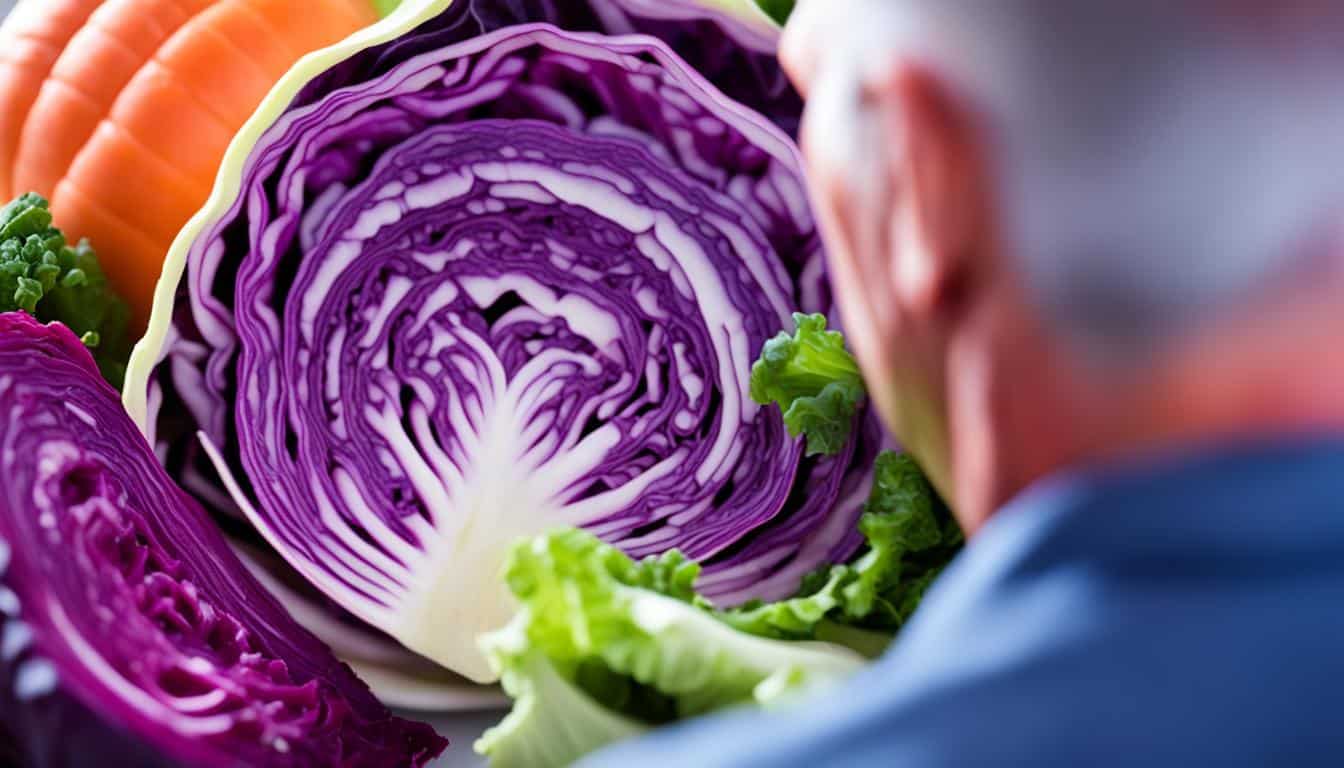
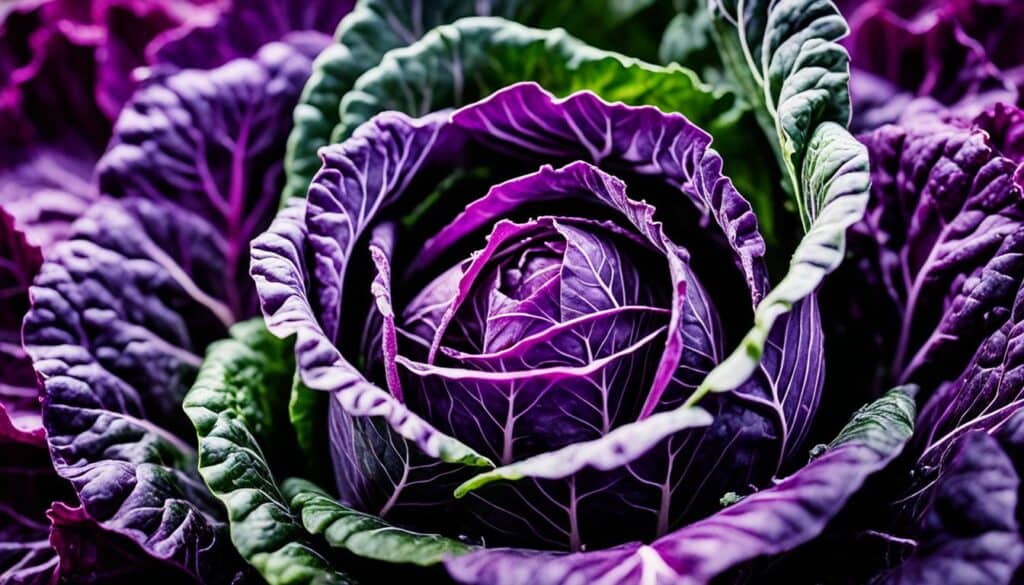
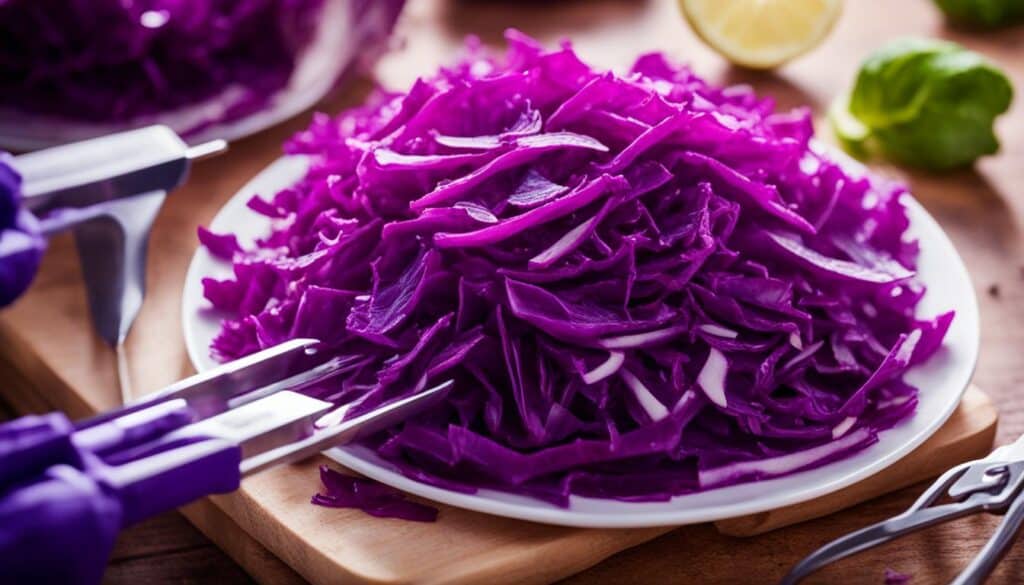
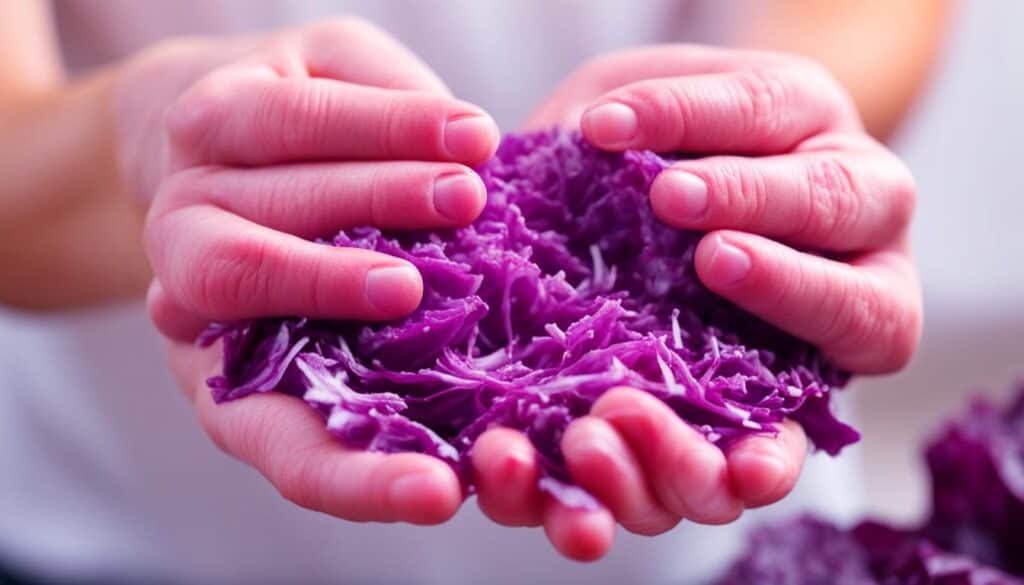
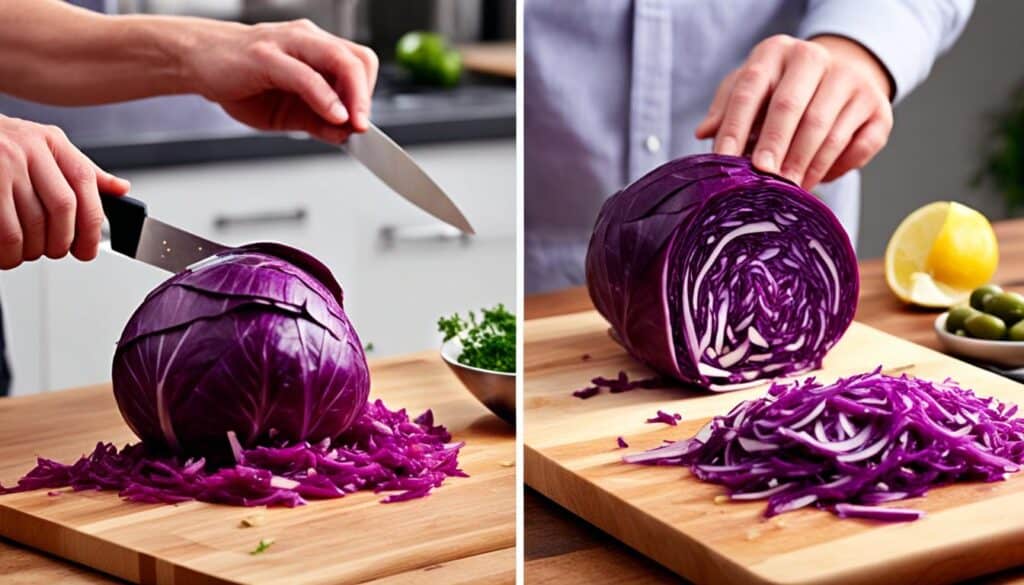
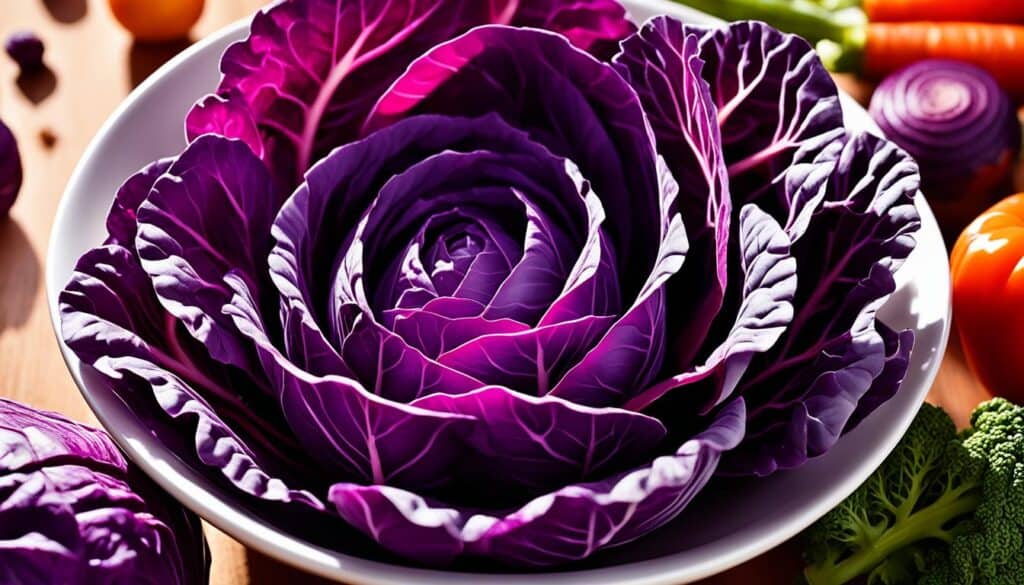



Leave a Reply